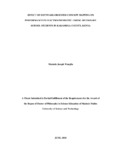| dc.description.abstract | This studydeterminedthe effectof using Software-Oriented Concept Mapping on performance in electrochemistry among secondary school students in Kakamega County, Kenya. Itwas based on David Ausubel’s Meaningful Learning Theory, andimplemented through a sequential mixed methods approach.Quasi-experimental research design, using non-randomized pretest-posttest control group model,was adopted to implementthe study’s quantitative phase,while focus group interviews were used forthe qualitative phase. Target population was 4,000 form four students and 30 Chemistry teachers from secondary schools in Kakamega County, which offer computer studies. A sample of 400 students and 10 teachers was selected by multi-stage sampling procedure, through a combination of purposive, proportionatestratified and simple random sampling techniques. The dependent variable wasacademicperformance at five levels; achievement,self-efficacy, attitude, motivation and experimental skills,while the independent variable wasinstructional strategy at two levels; Software-Oriented Concept Mapping and Conventional Instructional Strategies. Students’ gender and school type were the intervening variables. The study was piloted two weeks to the actual study,in two secondary schools within Kakamega County. Observation check-lists, close-ended questionnairesand standardized achievement tests were used to collect the study’s quantitativedata,while focus group interviewguideswereused to collectqualitative data. All the research instruments were validatedusing the Rasch Model, while reliability of the quantitative instruments was assessed,also using data from the pilot study, via the internal consistency alpha coefficients method.Percentage validityscoresfor the instruments ranged between74and86,while their reliability coefficients ranged between 0.729 and 0.877, both measures surpassingthe minimum thresholds set by various educational research experts. Frequencies, percentages, meansand standard deviationswere employed to analyze the collected quantitative data descriptively. The study’s null hypotheses were tested inferentially at the 0.05 alpha level of statistical significance, using parametrictests. These included;2×1 Factorial ANOVA, One-Way ANOVA, Bivariate Pearson’s Correlation, ANCOVAand StandardMultiple Linear Regression.Qualitative dataon the other hand were analyzed in themes as theyemerged. Findings revealed a significantlysuperioreffectof Software-Oriented Concept Mapping on students’ academic performance in Electrochemistry when compared to the useof Conventional Instructional Strategiesto teach the same topic. These findings have important instructional implications in the field of Chemistryeducation. It is recommended that Chemistry teachersand studentsin Kenya should fully incorporate the use of Software-OrientedConcept Mapping in their daily teachingand learning,so as to mitigatethe low academic performance currently being reported in the subjectat national level. | en_US |

